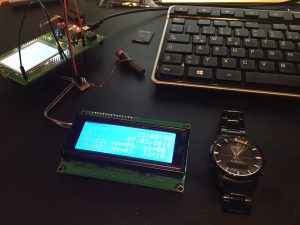Hallo Mikrocontroller Fans,
weil ich hier ein DCF77 Emfangsmodul (DCF1 von Pollin Electronic GmbH) rumliegen hatte, dachte ich mir, das wäre doch ideal für ein kleines Demo mit der neuen I2C Text LCD Library. Ich habe die 96-DCF77-Library (STM32F4) eingebunden und für den STM32F429 portiert.
Das I2C Text LCD habe ich an folgenden Pins angeschlossen:
- GND an GND
- VCC an +5V
- SDA an PC9
- SCL an PA8
Das DCF77 Empfangsmodul benötigt folgende Anschlüsse:
- VCC an +3V
- GND an GND
- DATA an PB0
- PON – nicht belegt
Features:
- Wahlweise an 16×2 oder 20×4 LCD verwendbar
- Automatischer I2C Portscan
- LCD Hintergrundbeleuchtung mittels User Button ein- und ausschaltbar
- Grüne LED zeigt aktive Verbindung zum DCF77 Sender
- Rote LED zeigt Sekundensignal
- Uhrzeit läuft auch bei unterbrochener Verbindung zum DCF77 Sender weiter
Hier zwei Bilder vom Testaufbau mit Vergleich der ermittelten Zeit zu meiner CASIO Funkuhr:
Main.c:
1 2 3 4 5 6 7 8 9 10 11 12 13 14 15 16 17 18 19 20 21 22 23 24 25 26 27 28 29 30 31 32 33 34 35 36 37 38 39 40 41 42 43 44 45 46 47 48 49 50 51 52 53 54 55 56 57 58 59 60 61 62 63 64 65 66 67 68 69 70 71 72 73 74 75 76 77 78 79 80 81 82 83 84 85 86 87 88 89 90 91 92 93 94 95 96 97 98 99 100 101 102 103 104 105 106 107 108 109 110 111 112 113 114 115 116 117 118 119 120 121 122 123 124 125 126 127 128 129 130 131 132 133 134 135 136 137 138 139 140 141 142 143 144 145 146 147 148 149 150 151 152 153 154 155 156 157 158 159 160 161 162 163 164 165 166 167 168 169 170 171 172 173 174 175 176 177 178 179 180 181 182 183 184 185 186 | //-------------------------------------------------------------- // File : main.c // Datum : 8.03.2018 // Version : 1.00 // Autor : Manfred Becker (MB) // EMail : - // Web : http://mikrocontroller.bplaced.net/ // CPU : STM32F407 (Discovery-Board) // IDE : CooCox CoIDE 1.7.8 // GCC : 4.7 2012q4 // Module : CMSIS_BOOT, M4_CMSIS_CORE // : stm32_ub_led.c (ab Version 1.0) // : stm32_ub_button.c (ab Version 1.0) // : stm32_ub_i2c1.c (ab Version 1.3) // : stm32_ub_i2c2.c (ab Version 1.3) // : stm32_ub_i2c3.c (ab Version 1.3) // : stm32_ub_lcd_text_i2c.c (ab Version 1.0) // : stm32_ub_dcf77.c (ab Version 1.0) // : printf.c (ab Version 07.11.2013) // Funktion : Demo der LCD Text Anbindung ueber I2C-LoLevel-Library // Hinweis : Diese zwei Files muessen auf 8MHz stehen // "cmsis_boot/stm32f4xx.h" // "cmsis_boot/system_stm32f4xx.c" //-------------------------------------------------------------- #include "main.h" #include "stm32_ub_lcd_text_i2c.h" #include "stm32_ub_dcf77.h" #include "stm32_ub_button.h" #include "stm32_ub_led.h" #include "stdio.h" // fuer sprintf() Funktion //-------------------------------------------------------------- // Pause (ohne Timer) // Delay : in ms //-------------------------------------------------------------- void Delay(uint32_t delay) { uint32_t ms = delay * (SystemCoreClock / 15000U); while(ms--) { } } int main(void) { LCD_TEXT_DISPLAY_t myLCD = { TI2C3, // I2C Modul (1=I2C1, 2=I2C2 oder 3=I2C3) 0, // I2C Adresse des LCD Displays. Falls unbekannt dann auf 0 setzen und PortScan laufen lassen. 20, // Anzahl Zeichen je Zeile 4, // Anzahl Zeilen 1 // LCD Hintergrundbeleuchtung (0=Aus, 1=Ein) }; DCF77_Status_t status,old_status=99; uint8_t old_sek = 99; uint8_t tick = 0; uint8_t ss=0,mm=0,hh=0,DD=0,MM=0,JJ=0; char buf[20+1]; char date[10+1]; char time[8+1]; SystemInit(); // Quarz Einstellungen aktivieren UB_Button_Init(); // Init der Buttons UB_Led_Init(); // Init der LEDs // Init der I2C1-Schnittstelle UB_I2C_Init(&myLCD); // I2C Port Scan starten? if (myLCD.slave_adr==0x00) { // I2C Port Scan starten von 0x01 bis 0x7F if ((myLCD.slave_adr = UB_LCD_TEXT_I2C_PortScan(&myLCD, 0x01, 0x7F)) != 0x00) { char txt[16]; sprintf(txt,"I2C-Adr: 0x%02x", myLCD.slave_adr); // Init vom LC-Display UB_LCD_TEXT_I2C_Init(&myLCD); // Text auf Zeile-1 ausgeben UB_LCD_TEXT_I2C_String(&myLCD,0,0,txt); UB_LCD_TEXT_I2C_Delay(3000); } else { //ToDo: Fehlerbehandlung } } // Init vom LC-Display UB_LCD_TEXT_I2C_Init(&myLCD); // init vom DCF77-Modul UB_DCF77_Init(); UB_LCD_TEXT_I2C_String(&myLCD,0,0,"DCF77"); while(1) { // Test auf OnClick vom Button if(UB_Button_OnClick(BTN_USER)==true) { UB_LCD_TEXT_I2C_Backlight_Toggle(&myLCD); // LCD Hintergrundbeleuchtung toggeln } Delay(100); //UB_LCD_TEXT_I2C_Delay(100); UB_Led_Off(LED_RED); // rote LED ausschalten status=UB_DCF77_ReadTime(); if(status!=old_status) { old_status=status; if(status==DCF77_NO_SIGNAL) UB_LCD_TEXT_I2C_String(&myLCD,0,1,"No signal!"); if(status==DCF77_READING) UB_LCD_TEXT_I2C_String(&myLCD,0,1,"Reading..."); if(status==DCF77_TIME_ERROR) UB_LCD_TEXT_I2C_String(&myLCD,0,1,"Error! "); if(status==DCF77_TIME_OK) UB_LCD_TEXT_I2C_String(&myLCD,0,1,"OK! "); } if(status==DCF77_TIME_OK) { UB_Led_On(LED_GREEN); // grüne LED einschalten if(DCF77_TIME.sek!=old_sek) { old_sek=DCF77_TIME.sek; hh=DCF77_TIME.std; mm=DCF77_TIME.min; ss=DCF77_TIME.sek; DD=DCF77_TIME.tag; MM=DCF77_TIME.monat; JJ=DCF77_TIME.jahr; sprintf(time,"%02d:%02d:%02d",hh,mm,ss); UB_LCD_TEXT_I2C_String(&myLCD,myLCD.maxx-8,0,time); if (myLCD.maxy>=2) { sprintf(date,"%02d.%02d.20%02d",DD,MM,JJ); UB_LCD_TEXT_I2C_String(&myLCD,myLCD.maxx-10,1,date); } if (myLCD.maxy>=3) { sprintf(buf,"hh=%02d, mm=%02d, ss=%02d",hh,mm,ss); UB_LCD_TEXT_I2C_String(&myLCD,0,2,buf); } if (myLCD.maxy>=4) { sprintf(buf,"DD=%02d, MM=%02d, JJ=%02d",DD,MM,JJ); UB_LCD_TEXT_I2C_String(&myLCD,0,3,buf); } tick = 0; UB_Led_On(LED_RED); // rote LED einschalten } } else { UB_Led_Off(LED_GREEN); // grüne LED ausschalten if ((tick++)>=10) { tick = 0; if ((++ss)>=60) { ss=0; if ((++mm)>=60) { mm=0; if ((++hh)>=24) { hh=0; } } } sprintf(time,"%02d:%02d:%02d",hh,mm,ss); UB_LCD_TEXT_I2C_String(&myLCD,myLCD.maxx-8,0,time); UB_Led_On(LED_RED); // rote LED einschalten } } } } |
Downloads:
Ich habe jeweils für STM32F407-Disco und STM32F429-Disco die kompletten CooCox Projektordner für euch zum Download bereitgestellt.

Hier der komplette CooCox-Projektordner zum Download :

Hier der komplette CooCox-Projektordner zum Download :
Viel Spass damit,
Manfred




